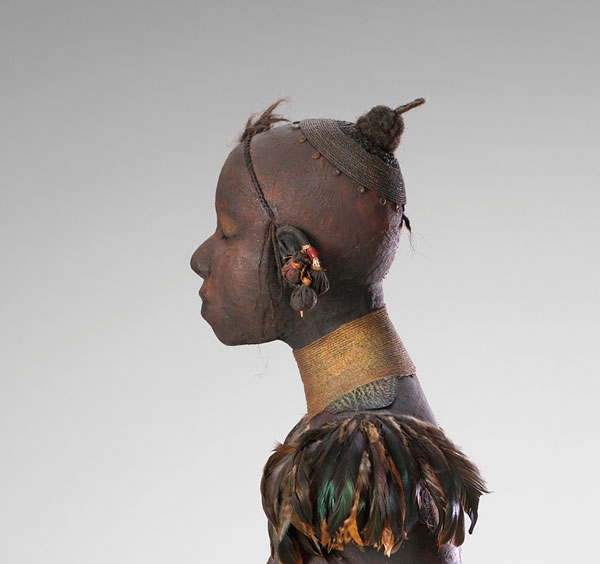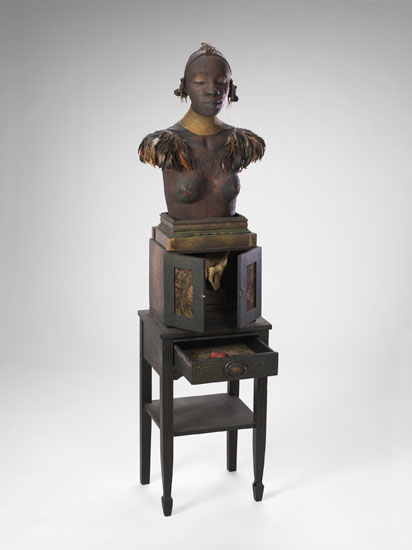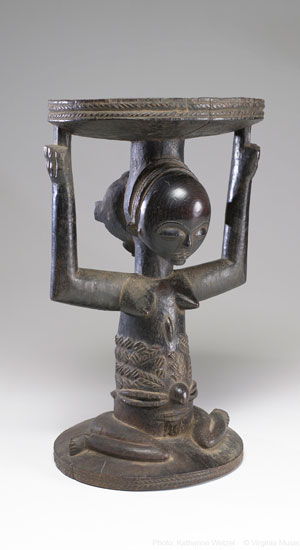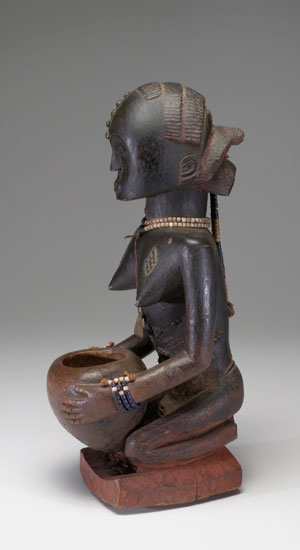Goddess of Love and Beauty:
Renée Stout’s Erzulie Dreams
Renée Stout’s concept for this work derives from Erzulie, the Haitian goddess of love, procreation, and motherhood, who shares traits with Oshun, the Yoruba orisa (deity) of love, beauty, and wealth. The goddess has different manifestations, and here, as Erzulie Freda, she also appears as a divinity of dreams. Stout transforms the figure into a self-image by placing a cast of her own head and face on the alluring torso with its delicate feathers, beads, and lace. Her softly closed eyes transport us to a world of seductive visions.
 |
Renée Stout (b. 1958) |
Erzulie rises from a small cabinet. Does this form an altar? The drawer opens, revealing a red beaded heart; the doors open, revealing a pelvis. This inner core—the locus of fertility, childbearing, and loving emotion—are these powers revealed to those who dream of her?
 |
Renée Stout (b. 1958) |
In Africa’s richly artistic Congo region, sculptures are often made to serve as containers for mystical ingredients that identify and activate powers relevant to the spirit, deity, or ancestor represented. Such sculptures are called minkisi (singular—nkisi). They serve as altars where contact with spirits take place and as instruments of divination in processes that help a person, family, or community understand the issues that confront them, the better to overcome obstacles, meet needs, or fulfill desires. Like them, Erzulie contains forces within, as revealed by the elements inside the open drawer and doors.
| I’m attracted to spiritual societies . . . . [Spirituality] seems like a means of survival in a world that you can’t always understand. | |
| —Renée Stout | |
The art of Congo’s Luba people has been described as a hymn to womanhood, and Stout’s Erzulie Dreams relates in its essence two Luba female figures in the museum’s collection. In one of these “cousins” of Erzulie, a seated woman holds a bowl. Whether it is a bowl of divination implements—women are often diviners—or white clay to rub on the body for rituals, the nurturing role of woman is unmistakably affirmed. The other sculpture, a royal stool, depicts a woman holding aloft the seat for a chief. From her position, planted on the earth, she visually and physically provides the essential link between the ancestors beneath the earth and the living ruler who sits upon the stool.
 |
 |
|
Royal Stool, 19th–20th century |
Kneeling Woman Holding a Bowl, ca. 19th century Luba culture (Democratic Republic of the Congo) Wood, string, glass beads, button, brass tacks, Belgian colonial currency Virginia Museum of Fine Arts. Purchased with funds from the Adolph D. and Wilkins C. Williams Fund 93.50 Photo by Katherine Wetzel © Virginia Museum of Fine Arts |
Visions from the Congo is organized by the Virginia Museum of Fine Arts and curated by Richard B. Woodward, Curator of African Art.
Introduction: Visions from the Congo
A Rising of the Wind: Art from a Time of Rebellion in the Congo
Things Man Made: Allison Saar’s Untitled (from the Crossroads installation)
Goddess of Love and Beauty: Renée Stout’s Erzulie Dreams